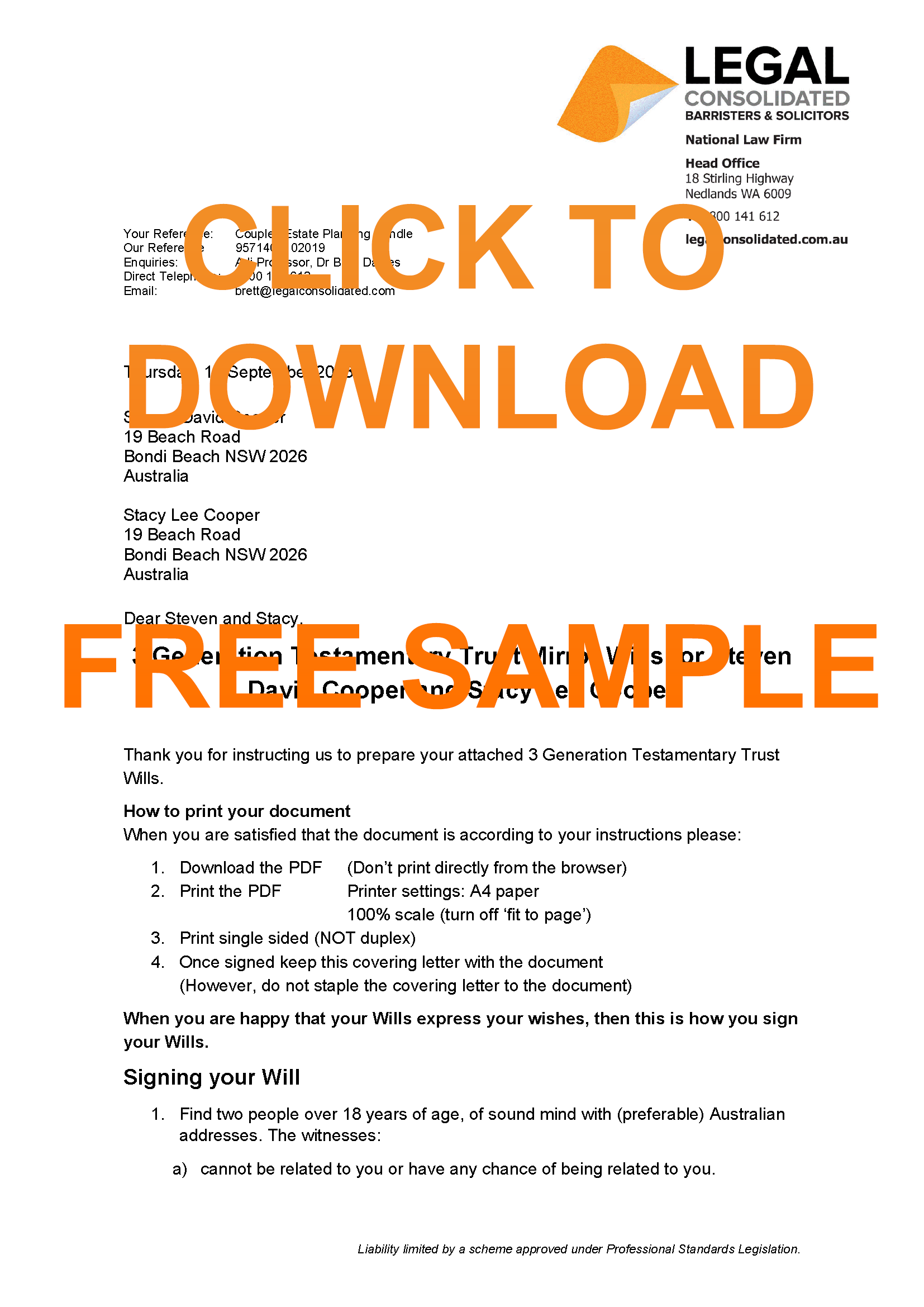
Service Trust Agreement
$448 includes GST
-
• Designed to work throughout Australia • Complies with ATO's latest rulings
• Designed for Family Trusts, Unit Trust, partnerships and companies
Service Trust Agreement
A Service Trust Agreement is the glue between the business and the service trust that services that business. It is common practice for businesses to use a service trust (service entity). A service trust is often a:
- Family Trust – for a single business owner
- Unit Trust – if 2 or more business owners
- Company – not common as profit is trapped and no CGT relief. But useful if you have no family because of the 30% tax rate
Build these 3 types of service trusts on our website. Designed to take advantage of Fortunatow v FCT [2019] FCA 1247.
A service trust is a second business

The service trust is a second business. The service trust provides services to the business. It charges a fee for providing those services. Service trust profits are shared with the business owner’s spouse, children and family. They pay tax at a lower marginal tax rate. Therefore, the service trust saves tax. It helps with superannuation benefits and the spreading of income to family members.
But it is not enough to have just a service trust. You need the agreement between the business and the service trust. This agreement is called a Service Trust Agreement. The Service Trust Agreement is a contract. It allows the service trust to supply equipment, staff, receptionist, tools, factory, premises and administration services to the business.
When did the first Australian service trust start?
In 1956 eight doctors got together in Cessnock, New South Wales. They set up 8 corporate trustees. This is one for each of their respective family trusts. See Peate v FCT (1966) 116 CLR 38.
Service Trust Agreements are also popular for:
- Other professionals such as engineers, doctors, dentists, accountants and lawyers that cannot otherwise share profit easily.
- Asset protection – one entity holds the high-risk activities (employees, tenancies & advice) the other keeps all the ‘good’ assets (land, intellectual property) in a low-risk entity.
- Companies wanting to liberate wealth and move profit into a trust structure. Unlike a company, the service trust can access the CGT tax concessions. Therefore, the service trust often holds appreciating assets. These include real estate, franchises, copyright and ‘leased out’ business names.
Where is the tax advantage of a service trust?
The service trust is a business. Via the Service Trust Agreement, it provides services, for a profit, to the business. The services are provided at ‘market rates’. This is required by the ATO TR 2006/2. The service trust then distributes any ‘profit’ it makes. This is from running the business. The profit goes to the non-working spouse, children and other taxpayers at a lower tax rate.
Example of a service trust
The firm brings in revenue of $1.6m. The Service Trust provides services to the firm. The Service Trust Agreement sets out the services. Services include cleaning the office, providing secretaries, maintaining a diary, computers, marketing, office lease and bookkeeping. The service entity owns the equipment and employs all non-partner staff.
The Service Trust (via the Service Trust Agreement) charges the firm $1.4m in fees.
By providing these services the Service Trust makes a profit of $.8m. (This is after it pays its expenses of $.6m.) That profit is distributed to the spouse, children and other trust beneficiaries.
The business cannot share ‘personal services income’. However, the service trust ‘income’ is not personal services income. This is because the service trust is a separate business to the firm’s practice. The service trust operates on an ‘arm’s length basis’. Therefore, the income is distributed to the spouse, children and other beneficiaries related to the business owners.
Does the ATO like ‘markups’ in service trusts?
Q: I am having trouble with the example of $1.6M Fees with Service Fee of $1.4M, Service Entity Costs of $0.6M and $0.8M available to be distributed discretionarily. The ATO missives imply that the ATO won’t accept an economically sustainable service fee rather a 30% uplift on salary costs and 10% on expenses and the service entity needs to be absorbing about 18% or more of the expenses leaving a net profit less than 10% of the total service fees, additionally the 10% profit cannot be more than 30% of the combined profit of the professional firm and service entity added together. The ATO’s position seems completely uncommercial and a service entity unviable for the average practice.
A: I think you are completely wrong and fundamentally do not understand what I and the ATO have said. I suggest you re-read this page and the ATO’s views on the matter. As I have stated since 1988 the ATO’s position on service trusts are completely correct. But so misunderstood. Firstly, to even contemplate ‘markups’ is just silly, lazy and wrong. Instead, concentrate on the service trust being a separate third party business. The ATO is just asking for commerciality. And the ATO is right. Rather than try and trap the ATO with these ridiculous and artificial notions of markups instead look to commercialism:
- Is the service trust behaving like a separate arms-length business?
- Do you have some quotes for cleaning the office from other cleaning companies?
- What does a bookkeeper charge in Kiama? It is probably different to what they charge in Bowral.
Independent Contractors Agreement vs Service Trust Agreement
A Service Trust Agreement is an Independent Contractors Agreement (‘contract for services’).
The principal (business) requests and pays for the services. The person providing the services is the contractor (service trust). The agreement between the principal and contractor is the Service Trust Agreement.
The contractor is ‘independent’. The contractor is not an employee of the principal (business).
What should the Service Trust charge?
Your accountant, each financial year, tells you what to charge. The Service Trust Agreement allows for this. You charge ‘market rates’. Treat the service trust as a separate non-related business. The Service Trust Agreement allows the service trust to provide many services, including:
- plant and equipment (desks, chairs, library, tools, equipment)
- non-partner staff (build the Employment Contracts here)
- consumables
- the premises
- budgeting, forecast, bookkeeping, accounting and debt collection services
- marketing, corporate design and identity and brand awareness
- additional services — as agreed by the parties from time to time
How do I update the Service Trust Agreement?
The Service Trust Agreement is updated by an exchange of emails. This is throughout the life of the Service Trust. Add more services as your accountant suggests over the years. You can also later add a scope of work, plans, diagrams and specifications.
The Service Trust Agreement is silent on what it charges the firm. Therefore, it is never out of date. Your accountant advises you on what the appropriate charges are during the financial year.
ATO’s view on service trusts
Practical Compliance Guideline PCG 2021/D2 (Allocation of professional firm profits)
Old ATO rules for Service Trusts
In June 2015, the ATO issued service trust guidelines. This is for allocating profits within professional firms.
But it was unceremoniously withdrawn in December 2017. The ATO suspended the application of its old guidelines:
Assessing the Risk: Allocation of profits within professional firms
These old guidelines provided that the professional risk of being audited was low if any of the following applied and there were no other compliance issues:
-
- the practitioner received income from the firm as an appropriate return for the services provided;
- the practitioner was assessed on at least 50% of the income to which the practitioner and the associates were collectively entitled; or
- the practitioner and the associates each had an effective tax rate of 30% or higher on the income received from the firm.
- the practitioner received income from the firm as an appropriate return for the services provided;
Why did the ATO scrap the old service trust rules?
The ATO noticed a variety of arrangements exhibiting high-risk factors. These were not contemplated within its old guidelines. The new sharp practices including the use of related-party financing and self-managed superannuation funds.
The ATO started a review. It wanted ‘certainty’ by 30 June 2018. Instead, the ATO allowed taxpayers with pre-14 December 2017 arrangements to continue to rely on the suspended guidelines. This is on a year-by-year basis. I thought that this was rather generous of the ATO.
ATO’s new Guidelines on Service Trusts – more complex
On 1 March 2021, the ATO issued a replacement guide. It is called:
Practical Compliance Guideline PCG 2021/D2 (Allocation of professional firm profits – ATO compliance approach) (Guide).
The Guide affects professional firms. But, it also affects any other person operating a:
- family trust service trust
- unit trust service trust
- company service trust
Guide 2021/D2 ‘looks like’ it only affect professionals
The Guide is concerned with an ‘individual professional practitioner’. This is where the professional redirects income from their practice to an associated entity. This includes a family trust, unit trust or company.
Obviously, this is where it has the effect of reducing the professional’s tax liability. The service trust usually pays tax at a lower overall amount.
The professional can use the safe harbours in the Guide. But first, you satisfy two “gateways”:
- Gateway 1 is the arrangement commercial?
- Gateway 2 requires that the arrangement is not high-risk. These are obvious examples of high risk:
- financing arrangements for non-arm’s length transactions
- abusing the difference between accounting standards and tax law
- where a partner assigns a portion of a partnership interest that are materially different from those in the:
- FCT v Everett (1980) 10 ATR 608; and
- FCT v Galland (1986) 18 ATR 33
- multiple classes of shares and units held by non-equity holders
What if you pass Gateways 1 and 2? The Guide provides a “risk assessment scoring table” that assigns a score depending on:
- the proportion of profit entitlement from the “whole of the firm group” returned in the hands of the professional
- the total effective tax rate for income received from the firm by the IPP and associated entities
- remuneration returned in the professional’s hands as a percentage of the commercial benchmark for the services provided to the firm
Those risk scores are added up to place you within a low, medium or high-risk level zone. This is green, amber or red. Green is good. Amber is neutral. Red is bad.
The Guide gives you and your accountant confidence that if your circumstances are low-risk then the ATO ‘will generally not allocate compliance resources to test the relevant tax outcomes’. That is code that they have bigger fish to fry.
PCG 2021/D2 vs Personal Services Income
Personal Services Income (PSI) is where you cannot share profit. For example, you are a ‘one-man band’. You are not a ‘business’. Obviously, the Guide does not apply to an enterprise that suffers from the personal services income rules.
The Guide does not relieve taxpayers of their legal obligation to self-assess their compliance with relevant tax laws. Get your accountant to check everything you do.
PCG 2021/D2 vs Part IVA
The general anti-avoidance provisions in Part IVA ITAA 1936 continue to apply. This is especially for ‘schemes’ designed to ensure the professional is not appropriately rewarded for the work he does in the firm.
Does PCG change anything for service trusts?
In Legal Consolidated’s view, the ATO’s latest views change nothing. It is more common sense from the ATO. I am embarrassed that the ATO had to again state the obvious.
I suggest that all clients in service trusts or wanting to be in a service trust cleave to the bosom of their accountant. Your accountant needs to make sure that you are ‘in the green’. This may involve detailed accounting and financial modelling. Part of that process is to build a service trust agreement. It is the glue between the professional and the service trust providing services to the professional.
Some professionals re-structure to get into the green low-risk area. This may trigger transfer (stamp) duty and Capital Gains Tax.
The Guide also provides examples. This is determining the “effective tax rate”. It includes some great case studies. I enjoyed reading them. They make sense. But talk with your accountant for the final sign off.
See also:
Please read the article by Professor Bret Davies titled Why the worry with Service Trusts.
Business Structures for Personal Services Income, tax and asset protection
Family trust v Everett’s assignments
- Family Trust Deed – watch the free training course
- Family Trust Updates:
- Everything – Appointor, Trustee & Deed Update
- Deed ONLY – only update the Deed for tax
- Guardian and Appointor – only update the Guardian & Appointor
- Change the Trustee – change human Trustees and Company Trustees
- The company as Trustee of Family Trust – only for assets protection?
- Bucket Company for Family Trust – tax advantages of a corporate beneficiary
Unit trust vs Everett’s assignments
- Unit Trust
- Unit Trust Vesting Deed – wind up your Unit Trust
- Change Unit Trust Trustee – replace the trustee of your Unit Trust
- Company as Trustee of Unit Trust – how to build a company designed to be a trustee of a Unit Trust
Corporate structures and Everett’s assignments
- Partnership Agreement – but what about joint liability?
- Incorporate an Australian Company – best practice with the Constitution
- Upgrade the old Company Constitution – this is why
- Replace lost Company Constitution – about to get an ATO Audit?
- Independent Contractor Agreement – make sure the person is NOT an employee
- Service Trust Agreement – operate a second business to move income and wealth
- Law firm Service Trust Agreement – how a law firm runs the backend of its practice
- Medical Doctor Service Trust Agreement – complies with all State rules, including New South Wales
- Dentist Service Trust Agreement – how dentists move income to their family
- Engineering Service Trust Agreement – commonly engineers set up the wrong structure
- Accountants Service Trust Agreement – complies with ATO’s new view on the Phillips case

